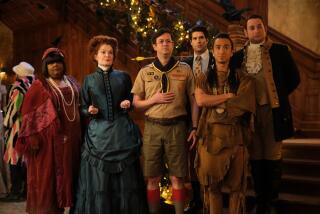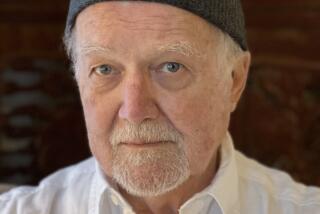BOOK REVIEW : A Chronicle of Our Descent From ‘Giants’ : MURTHER AND WALKING SPIRITS<i> by Robertson Davies</i> Viking $21.95, 357 pages
- Share via
Robertson Davies has considered a remarkable fact and attempted to turn it into a novel. The fact is one that has to do with possibly most of us living in Canada and the United States. It is remarkable not only in itself but also in that relatively few of us have really remarked on it.
We--accountants, factory workers, farmers, lawyers, clerks, postmen, real estate brokers, writers, tycoons--have giants in our lineage, three, four, five, six generations back. The great-great-great-great-grandparents of an Englishman, Frenchman, Italian or Spaniard may well have lived in roughly the same place, if not the same fashion, as their descendants. Our forebears, at some point, ventured a prodigious feat of dislocation.
“Murther and Walking Spirits” begins--after a preliminary section I will get to--with two such prodigies. One is Anna Vermeulen Gage, a Loyalist whose husband, a British officer, is killed in our Revolutionary War. Taking what money she can rescue from her confiscated properties, she embarks in a canoe with her three children and, through months of ordeal, paddles the Hudson River from New York City to Canada, where she has wealthy Dutch relatives.
The second giant is Tom Gilmartin. We encounter him at around the same time--the last part of the 18th Century--preaching the gospel of his friend and mentor, John Wesley, to outlaws and unlettered crofters in the wild mountains of Wales.
Tom and Anna are united--six generations down and after tumultuous rises and falls in family fortunes and circumstances--in the persons of the mother and father, respectively, of the book’s narrator, Connor Gilmartin. He is a clever man, a sophisticated man, a decent man, even; but no giant. He is the arts editor of a metropolitan newspaper, and his temperament, interests and talents could not be further removed from the epic mode.
Davies attaches this exemplar of our butterfly intellectuals to the substantial, richly grained but ponderous wheel of our continental history. The awkwardness with which he does it is startling in a writer of his own giant-like accomplishments. There are enthralling moments in the generational chronicle of the Gilmartins and the Vermeulens, but the device with which it is framed pretty much wrecks it.
Connor and the reader enter the book together, trippingly. The arts editor finds his wife in bed with his theater critic. The critic strikes him dead with a blunt object. Thereafter, Connor is a ghost. Continuing, as ghosts are reputed to do, with the last thing on his mind before dying, he attends a film festival. The films, however, are sequences in the lives of his ancestors.
Throughout these “films,” told straightforwardly and often winningly, the ghost’s voice breaks in, alternatively blithe, sardonic, reflective and, more often than not, annoying. Particularly annoying is its periodic dragging-in and discussion of the lame-at-birth film device.
When let alone, the family history is often compelling. Anna, the paddler, makes an astonishing and redoubtable character; so does her docile but spirited daughter, Elizabeth. Their descendants in the female line, down to Connor’s paternal grandmother, are frustrated, dreamy or sour.
The men have more substance. The most vivid and appealing figure in the book is William McOwny, who marries Anna’s great-granddaughter, Virgie. William, a Scottish immigrant, is a master carpenter who builds some of the grandest houses in town. His downfall comes with his crowning triumph. He completes, lavishly, the town church, is bilked out of his fees by the church elders and is ruined. He lives on, disgraced, patronized by Virgie’s wealthy family and driven to near-madness by her own cold and calculated hatred. Wrecked as he is and tragically abused, he is a grand and flamboyant figure.
The descent of the Welsh Methodist evangelist is filled in more completely. Tom Gilmartin peddles cloth as well as salvation; his adopted son, Wesley, builds the business up; his grandson, Samuel, makes a small fortune and becomes an alderman, then mayor. As prosperity grows over the generations, zeal dwindles to faith, faith to piety, piety to observance. Samuel goes bankrupt; the business is shakily built up by his son, Walter, whose gentleness leads to a new bankruptcy and migration to Canada.
There, Walter’s son, Rhodri, starts as a printer’s apprentice and becomes a newspaper magnate. He marries Malvina, the great-great-granddaughter of Anna; and the two lines are joined. The results are Brochwell, a ruminatively witty English professor, and Brochwell’s son, untimely coshed into a ghost.
Untimely and unfortunately. The story of the Vermeulens and the Gilmartins, of the rise and fall and rise of families over the generations, is frequently vivid and engrossing, although it can fall into dull sequences. Whether it would have stood alone is hard to say. The “Murther and Walking Spirits” of the title--plus the movies--are so much silly capering in place.
Next: Elaine Kendall reviews “The Disappearing Moon Cafe” by Sky Lee (The Seal Press).
More to Read
Sign up for our Book Club newsletter
Get the latest news, events and more from the Los Angeles Times Book Club, and help us get L.A. reading and talking.
You may occasionally receive promotional content from the Los Angeles Times.










